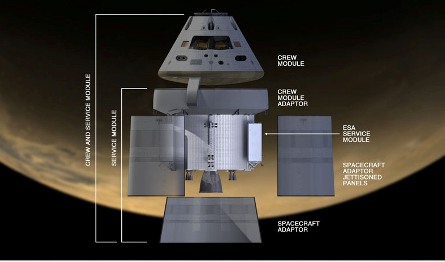NASA and the European Space Agency (ESA) have put more detail on their agreement for ESA to build the service module for NASA's Orion crew exploration vehicle. The €450 million ($600 million) deal will see ESA adapt its Automated Transfer Vehicle (ATV) robotic supply ship, which has been servicing the International Space Station since the retirement of NASA’s Space Shuttle, to construct the service module that will allow crew to travel to and the Moon. This service module will be part of ESA’s contribution to the ongoing barter arrangement, under which partners divide running costs of the orbital outpost.
While ESA will be concentrating on the baseline systems including tankage, electronics and consumables, most of which have been derived from the ATV cargo vessel, NASA and Lockheed Martin will still be supplying the service module's main engine, which will be derived from the Space Shuttle's OMS (Orbital Manoeuvring System) engines.
 |
|---|
NASA |
The most noticeable external change to the structure of Orion and its service module ensemble will be new ATV-style rectangular solar arrays rather than the originally envisaged circular ones. NASA and Lockheed Martin remain in charge of the main structural interface pieces and crew module adapter.
While Lockheed Martin was originally contracted by NASA to build the service module, it will not be out of pocket. Instead, the funding that was to be used for this work will now be reallocated to other Orion and SLS programme activities.
ESA human spaceflight director Thomas Reiter celebrated the agreement as "the start of extended co-operation."
While the International Space Station's high cost is often cited as an example of what can go wrong with an international space programme, NASA’s associate administrator for human exploration and operations William Gerstenmaier noted that while he had some fears but remains optimistic. NASA, he said, remains responsible for all launch-load bearing structures, which eases ESA’s engineering burden – though he stressed that the service module was a critical-path component without which Orion cannot carry human crew beyond low-Earth orbit.
As for the craft’s ultimate destination, missions to the Moon or even an asteroid are seen as possibilities. Said Reiter: "This vehicle as a certain operational flexibility as to what destination will be chosen."
For the time being the plan is for the first EFT-1 flight (Exploration Flight Test) to test most of the NASA major parts, in 20 months’ time via an Atlas-V launch. The ESA service module to fly on the later EM-1 and EM-2 flights using the SLS vehicle in 2017 and 2021 respectively. Mark Geyer, NASA Orion programme manager, said there would be no ESA hardware aboard the Atlas-launched EFT-1 flight: "This flight is about the crew module and key space separation events."
Source: Flight International










































